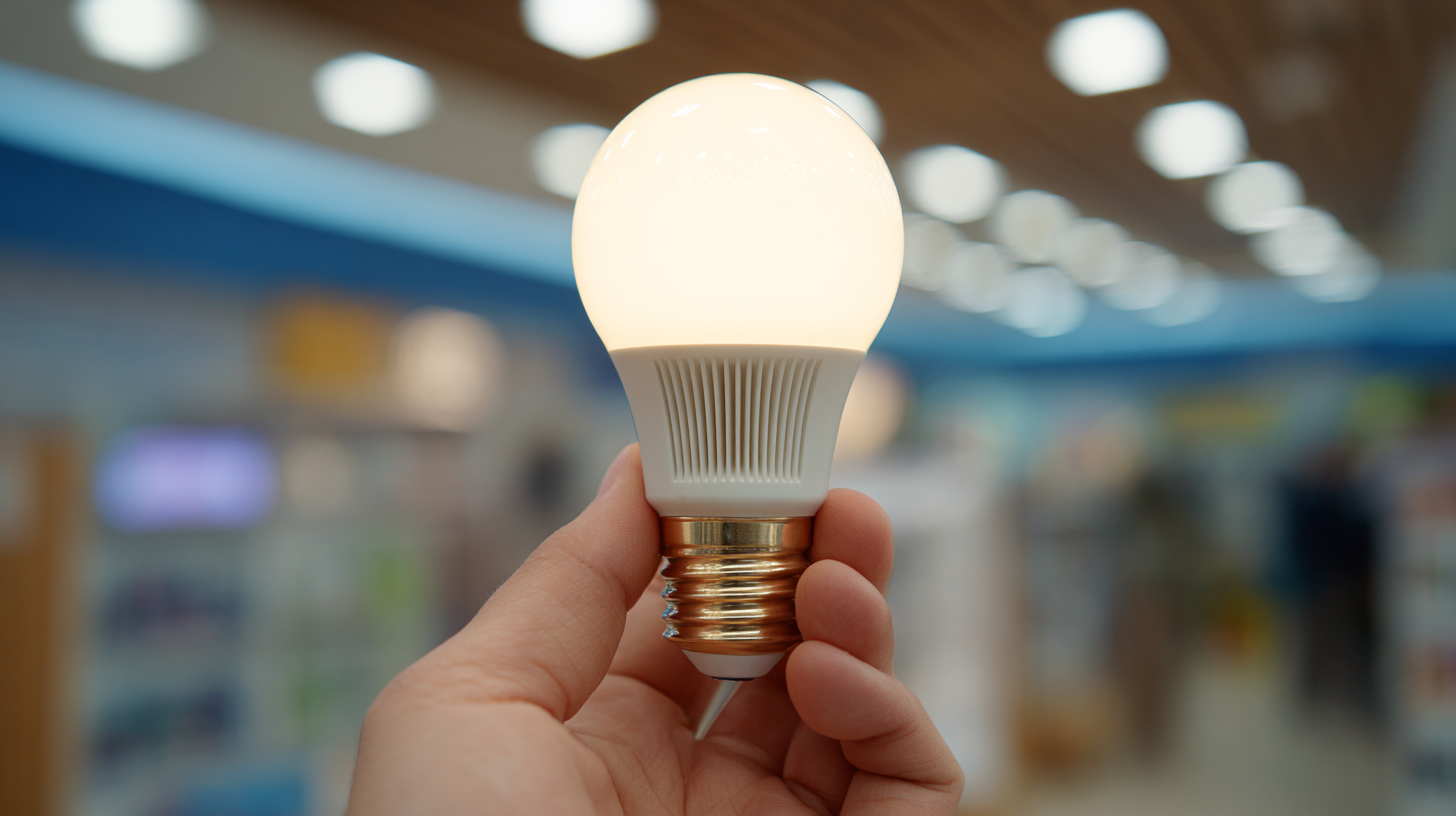Exploring the Future of LED Light Bulbs: Insights from China’s 138th Canton Fair in 2025
As the lighting industry continues to evolve, the future of LED light bulbs remains a pivotal topic of discussion, particularly following insights garnered from China's 138th Canton Fair in 2025. Recent data from the International Energy Agency highlights that LED lighting has accounted for over 60% of global lighting sales, significantly contributing to energy efficiency and sustainability efforts worldwide. This shift is projected to escalate, with LED technology expected to dominate more than 80% of the market share by 2030. The Canton Fair serves as a critical platform for industry stakeholders to showcase innovative LED light bulb designs and breakthroughs in technology, reflecting the rapid advancements in smart lighting solutions. With a growing focus on energy conservation and eco-friendly alternatives, LED light bulbs are not only revolutionizing how we illuminate our spaces but also shaping the future of the global lighting landscape.

Innovations in LED Technology Showcased at the 138th Canton Fair
The 138th Canton Fair, which opened on October 15, 2025, has become a dynamic platform for showcasing the latest advancements in LED technology. This year's fair places a strong emphasis on innovation, intelligence, and sustainability, highlighting the vital role of LED lighting in creating more energy-efficient and environmentally friendly solutions. Exhibitors are demonstrating how new developments in LED components are not only enhancing performance but also enabling smarter lighting systems that can adapt to various settings and user needs.
Notably, the event underscores the importance of Shenzhen as a focal point for LED innovation, where companies are pushing the boundaries of technology. These innovations reflect broader trends in the market, advocating for a shift towards integrated lighting solutions that blend seamlessly with smart home technologies. The spotlight on LED advancements at the Canton Fair reinforces the notion that lighting will continue to evolve, paving the way for smarter, more sustainable living environments in the near future.
Sustainability Trends in LED Lighting Featured by Leading Manufacturers
At the recent 138th Canton Fair in 2025, innovations in LED lighting took center stage, showcasing a significant shift toward sustainability among leading manufacturers. Participants highlighted the increasing demand for energy-efficient products, driven by both regulatory pressures and consumer awareness about environmental impact. According to the Global Energy Agency (IEA), LED lighting can reduce energy consumption by up to 80% compared to traditional incandescent bulbs, underscoring the potential for substantial savings in energy costs and reduced carbon footprints.

Manufacturers at the fair presented new models featuring recyclable materials and innovative designs that minimize waste. This aligns with the growing trend of sustainable production practices, where companies are not only focusing on the efficiency of their products but also on the sustainability of their manufacturing processes. For instance, a recent report by MarketsandMarkets projected that the global LED market will reach $105.2 billion by 2025, largely fueled by advancements in eco-friendly technologies.
Tips for consumers looking to adopt sustainable lighting solutions include choosing LED bulbs with a high Color Rendering Index (CRI) for better color accuracy and longer lifespans. Additionally, consider products that come with sustainability certifications, which assure you of their eco-friendly claims. By making informed choices, you can contribute to a greener future while enjoying the benefits of LED technology.
Market Insights: Consumer Preferences for LED Bulbs in 2025
As we move towards 2025, the LED bulb market offers intriguing insights into consumer preferences and trends that are shaping its future. The global market for flashlights is projected to surge to $960 million by 2025, with a compound annual growth rate (CAGR) of 5.8% anticipated through to 2034, reaching an estimated $1.59 billion. This growth is indicative of a larger trend in consumer preferences shifting toward more efficient and portable lighting solutions, showcasing the increasing reliance on battery-operated devices for convenience.
Similarly, the LED headlight market is expected to witness significant expansion, with projections indicating a size increase to $6.7 billion, boasting a robust CAGR of 10.18% from 2024 to 2032. This accelerated growth can be attributed to both enhancements in technology and a rising demand for sustainable lighting options. As consumers become more environmentally conscious, the transition to LED solutions that offer durability and energy efficiency is becoming increasingly appealing.
The embedded tilting market is also experiencing noteworthy growth, with an estimated size of $3.665 billion in 2025 and a projected CAGR of 6.99% until 2034. Understanding these market dynamics is essential for manufacturers and retailers aiming to cater to evolving consumer demands in the LED lighting landscape.
Exploring Consumer Preferences for LED Light Bulbs in 2025
This chart illustrates the preferences of consumers for different types of LED light bulbs based on insights gathered from China’s 138th Canton Fair in 2025. The data showcases the popularity of various features among consumers.
Opportunities for International Collaboration in the LED Industry
As the global spotlight shines on the LED industry, the recent insights garnered from China’s 138th Canton Fair in 2025 highlight significant opportunities for international collaboration. According to a recent report from MarketsandMarkets, the global LED market is projected to reach $100 billion by 2027, growing at a CAGR of 13.2% from 2022. This growth presents fertile ground for cross-border partnerships aimed at enhancing technological advancements and expanding market reach.
The Canton Fair showcased various innovative LED products, including smart lighting solutions and energy-efficient designs, attracting international exhibitors and buyers. According to the International Energy Agency, LED lighting is expected to account for over 70% of the global lighting market by 2030, emphasizing the need for collaboration among manufacturers, designers, and environmental organizations. This cooperation can help streamline supply chains and accelerate the adoption of sustainable practices in the LED sector. The synergies created through global partnerships will not only boost competitiveness but also contribute to greener, more energy-efficient lighting solutions worldwide.
Exploring the Future of LED Light Bulbs: Insights from China’s 138th Canton Fair in 2025
| Key Dimension | 2025 Projection | Growth Rate (%) | International Collaborations |
|---|---|---|---|
| Market Size (Billion $) | 15.2 | 8.5 | 3 New Partnerships |
| Production Capacity (Million Units) | 680 | 10.2 | Joint Ventures with 2 Companies |
| Energy Efficiency Improvement (%) | 22 | 5.0 | Research Collaborations with 4 Research Institutes |
| Export Growth (%) | 30 | 12.3 | Expansions into 5 New Markets |
The Role of Smart Technology in Modern LED Lighting Solutions
At the 138th Canton Fair in 2025, the spotlight on LED light bulbs showcased the transformative role of smart technology in modern lighting solutions. With the global smart lighting market projected to reach $29.5 billion by 2027, the integration of Internet of Things (IoT) features has become essential. Smart LED bulbs equipped with sensors and connectivity options allow for real-time monitoring, energy efficiency optimization, and enhanced user control through mobile applications. According to a recent report by Market Research Future, the demand for smart lighting is expected to grow at a compound annual growth rate (CAGR) of approximately 20% over the next five years, indicating a burgeoning interest in intelligent home automation.

The advancements highlighted at the fair also included the integration of artificial intelligence (AI) in LED lighting systems. Smart bulbs can now learn user patterns and adjust brightness and color based on preferences, which not only enhances the ambiance of spaces but also significantly reduces energy consumption. Data from Research and Markets reveals that the energy savings from using smart lighting solutions can exceed 50% compared to traditional lighting systems, making them an attractive option for both residential and commercial applications. As China continues to lead in LED innovation, the role of smart technology in promoting energy-efficient and user-friendly lighting solutions is set to expand even further.
Related Posts
-

What Are the Key Benefits of Using Grow Lights in Modern Agriculture?
-

What are the Advantages of Solar LED Technology for Sustainable Living
-

How to Leverage LED Technology for Energy Efficiency and Cost Savings in Your Business
-

Exploring Unique Alternatives to LED Wall Pack Lights for Your Outdoor Lighting Needs
-

How to Improve Outdoor Safety and Energy Efficiency with LED Wall Packs
-

Maximizing Your Outdoor Appeal with Landscape Lights Advantages and Industry Insights
